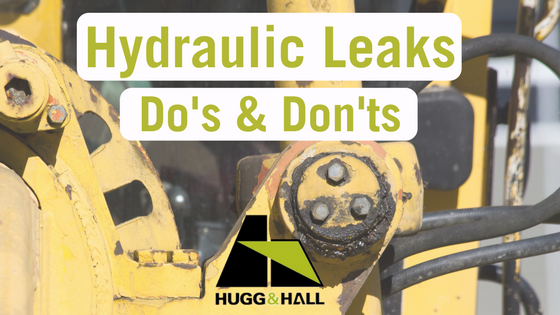
Hydraulic Leak Do’s & Don’ts
Chances are, if you work around or with construction equipment, you have seen or had to deal with a hydraulic leak. Hydraulic leaks are one of the most common issues our Service Department receives calls for day to day. Hugg & Hall has developed 9 Do’s and Don’ts to follow when you experience a hydraulic leak out in the field.
1. DO assess a leak as soon as it is noticeable.
A minor leak could be a sign of a more severe problem within your hydraulic system. Resolving the issue as soon as possible can help prevent further performance issues and inefficiencies. Time is of the essence for hydraulic leaks!
2. DON’T ever use your hand to check for a hydraulic leak!
Hydraulic fluid can reach temperatures of 300 degrees Fahrenheit or higher, which would result in a severe burn if it came into contact with your skin. These leaks can have a velocity of more than 600 feet per second and have been known to inject fluid through the skin, even when covered by thick leather gloves. Third-degree burns require immediate medical attention, can lead to possible amputation, and could result in industry safety violations.
3. DO tighten/torque correctly.
Incorrectly torqued 37° flare joints and compression-type tube fittings is a common cause of leaks. For flare joints, excessive torque can result in damage to the tube and connector; lacking in torque leads to scarce seat contact. For compression joints, incorrect torque can cause too much or too little “crush” on the ferrule. Fluid leaks are often the result of a loose nut, which is easily corrected with tightening.
4. DON’T just tighten to tighten.
Though hydraulic fluid leaks are occasionally the result of a loose nut, it’s possible for you to over-tighten. Over-tightening ruins the fitting integrity and is one of the most common causes of fitting leaks. Be sure to assess the fitting before you tighten to prevent any damage.
5. DO depressurize the system before a hydraulic inspection.
The system should be depressurized even if there is only a small amount of fluid leaking. By depressurizing your hydraulic inspection, you minimize the risk of hydraulic fluid bursting from a machine during inspection. However, be aware that fluid and pressure could still be present after the system is turned off.
6. DON’T replace with a different fitting just to save money/time.
Always replace a fitting with the same fitting type, even if that means having to wait longer for the part to get to you. Using a similar fitting and forcing it to work is asking for a disaster. If you are unsure of what fitting your equipment will need, contact our Parts Department and they can assist you!
7. DO check your lube.
80% of equipment component failures and faults are caused by polluted lubricant. Oxidation and contamination by water, dirt and the wear of metals, are two of the largest causes of hydraulic failure and can directly lead to leakage issues.
8. DON’T have open flames around hydraulic leaks.
It is common for people to forget that pinhole leaks can create mist-like clouds of highly flammable vapors. Common found hazards are lit cigarettes, using lighters or illumination, welding and/or cutting torches in use.
9. DO set up a maintenance schedule.
Hydraulic systems that are inspected regularly have a tendency to create fewer leak emergencies. Check for leaks, cracks and blisters, keep an eye out for hydraulic drips, and take time to locate the leak before it becomes a greater issue.
If you have any questions about your Hydraulic System, please contact the Hugg & Hall Service Department in your area.
Already know the fitting you need to replace? Contact our Parts Department to order one today!
Editor’s Note: Hugg & Hall originally published this post in August 2017. We updated it for freshness, accuracy, and comprehensiveness in April 2023.
Back to News
Subscribe and unlock cutting-edge equipment insights, trends and tips!
Subscribe